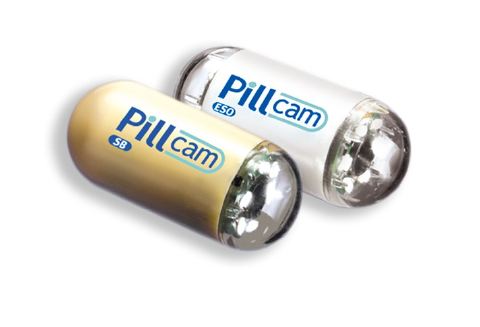Medical Imaging Technologies 2.0: Portable, Disposable, Wireless - Pillcam Is Here
The ubiquity of cheap, all but throwaway cameras is something we have come to take for granted. Web-cams and the advent of online video sharing have made broadcasting our internal lives to the world as easy and as commonplace as picking up the phone. But new medical technologies promise to make the literal broadcasting of our internal lives a reality, potentially changing the lives of millions of people.

Endoscopy is a word that strikes fear into anyone that knows its meaning. Should doctor's ever decide that they need to know what's going on inside your body, you will be faced with the extremely unpleasant prospect of having cameras fed into your digestive tract, from one end or another. Either way, it's no picnic, that's for sure.
Luckily medical imaging technologies are taking a radical turn for the better. Leading the way is an invention known simply as the Pillcam, a single-use, disposable micro-camera that can be swallowed as easily as a vitamin pill. The camera is able to take crystal-clear video images as it moves through the body, reaching parts of the digestive system even the most flexible wired cameras could never hope to record, without any of the discomfort and humiliation.
In many ways we are talking about medical imaging technology 2.0 - the shift towards the disposable, portable and wireless promises a giant leap in terms of the experience of patients and the results available to medical professionals alike. In this brief introduction, I take a look at how the technology works, and why it poses such radical hope for the patients and doctors in need of it.
The alternative
Medical technology is not always as cutting edge as the Pillcam, and the existing means of getting an accurate picture of a patient's internal health can be a gruesome prospect for all involved. Endoscopy, and its perhaps even less comfortable sibling colonoscopy, involve feeding a camera attached to a long tube either up the patient's nostril, and down into their stomach, or else directly up into the digestive system via the - well, you get the idea. Are you sitting comfortably? Then let me continue.
As someone unlucky enough to have been subjected to both, let me put you in the picture. From personal experience let me tell you that the experience of swallowing a greased tube that is being fed up your nose is not a pleasant one, and ranks among the most uncomfortable experiences of my life. The procedure seems endless, and the ever present gag-reflex doesn't make it any easier. Next time you want to give it a try, have a go at swallowing a meter of garden hose, and you'll get the idea.

An Endoscope - the alternative to Pillcam
I was personally, thankfully, spared full awareness of the alien-abduction treatment with a rather strong dose of anesthetic. But I can assure you that being wheeled into a room full of strangers standing around what looks like a gas pump with full knowledge of where the nozzle is going doesn't rank high on my must-do-again-sometime list.
In the age of wireless, portable, disposable technology these medieval torture devices really don't cut it. And this is why Pillcam offers so much hope to the millions that face these inhumane diagnostic technologies every year.
Pillcam - introduction
In this first video we are introduced to the Pillcam concept, and the main argument for its implementation - namely its ease of use.
As the video explains, rather than subjecting a patient to the procedures I briefly outlined above, they are simply asked to swallow the pill-sized camera. Then, wearing a receiver-belt, they go about their daily routine as the images are recorded to the camera's receiver, so that 24-hours later, doctors can analyze the entirety of the patient's GI tract using high quality images.
In addition to making the experience painless for the patient, the Pillcam also manages to bring back images that wouldn't be possible with the less flexible endoscopic tube-camera.
The Pillcam in action
So how does this lightweight medical technology do its job? In the following video, which is in the Portuguese language (translation coming soon), we see the ease with which medical practitioners can collect valuable information with this groundbreaking micro-technology.
While Pillcam is pricey at $300 a pop, this is not a procedure that is taken every day, and will hopefully find its way into mainstream medical practice, rather than being offered simply as a luxury treatment to those that can afford to buy into it. Nevertheless, as portable, wireless technology grows almost day by day in its power and ease of production increases there is some hope that Pillcam will lead the way in non-invasive, patient-friendly medical imaging technologies.
I for one am looking forward to that prospect.
Further reading
If you would like to learn more about Pillcam, you might want to take a look at the following websites:
- Given Imaging - manufacturer of the Pillcam
- Digg entry on Pillcam and images recorded using the device
- Sales and Marketing Network coverage of Pillcam's software component
- Patient experiences of the traditional endoscopy experience

blog comments powered by Disqus